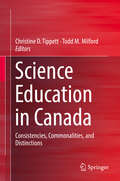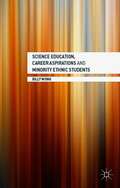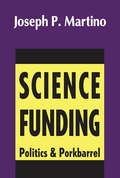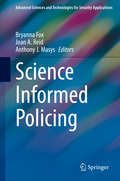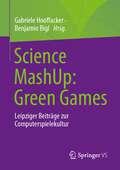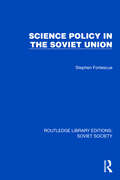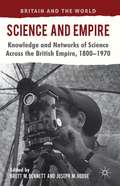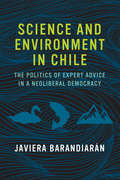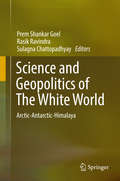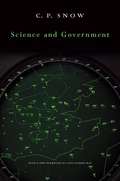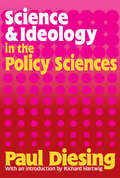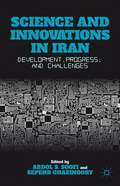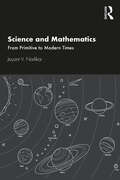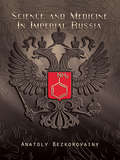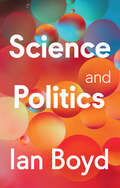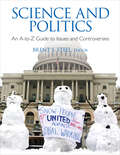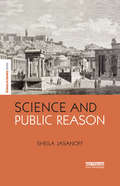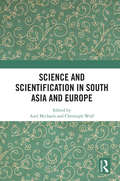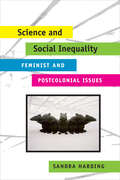- Table View
- List View
Science Education in Canada: Consistencies, Commonalities, and Distinctions
by Christine D. Tippett Todd M. MilfordThis book offers a meso-level description of demographics, science education, and science teacher education. Representing all 13 Canadian jurisdictions, the book provides local insights that serve as the basis for exploring the Canadian system as a whole and function as a common starting point from which to identify causal relationships that may be associated with Canada’s successes. The book highlights commonalities, consistencies, and distinctions across the provinces and territories in a thematic analysis of the 13 jurisdiction-specific chapters. Although the analysis indicates a network of policy and practice issues warranting further consideration, the diverse nature of Canadian science education makes simple identification of causal relationships elusive. Canada has a reputation for strong science achievement. However, there is currently limited literature on science education in Canada at the general level or in specific areas such as Canadian science curriculum or science teacher education. This book fills that gap by presenting a thorough description of science education at the provincial/territorial level, as well as a more holistic description of pressing issues for Canadian science education.
Science Education, Career Aspirations and Minority Ethnic Students
by Billy WongIs science typically for White men? Is science for 'people like us'? What are the barriers and opportunities? This book explores the science career aspirations of minority ethnic students. It investigates the views, experiences and identities of British Black Caribbean, Bangladeshi, Chinese, Indian and Pakistani youths in relation to science.
Science Funding: Politics and Porkbarrel
by Joseph MartinoAmericans have become resigned to seeing Congress vote money for porkbarrel projects of all kinds-roads, dams, post offices, military installations-in the districts of influential legislators. In recent years Congress has, almost without public notice, extended this form of vote-buying and pandering into a new domain: science. Where formerly scientific funding proposals were evaluated by outside experts on the basis of merit, there is now an increasing consideration of congressional districts and "fair" geographical distribution. In this ground-breaking volume, Joseph P. Martino offers a critical examination of special-interest funding and the danger it poses to the integrity of American society as a whole, as well as to its scientific component.Science Funding is distinguished by its comprehensive approach to the structural and historical background of the current situation. It examines the history of science funding from the early twentieth century through present, public vs. to taxpayers, instances of fraud, and the effects of government funding for research in universities.Martino's survey demonstrates conclusively that government has been inefficient in its funding capacity and that the shortcomings are inherent: political criteria for the support of science, congressional micromanagement, freezing out of innovative ideas, and the favoring of massive projects-Big Science-over small, but significant experimental programs. In his concluding chapter Martino provides an agenda for new thinking on the funding of science. He proposes alternatives that suggest a plurality of approaches is preferable to the current monolithic model, and shows how industrial support, philanthropy, and contributions from the public can be made more effective. Science Funding is a major work on the interaction of science, politics, and society. It will be of interest to sociologists, policymakers, and political scientist, and the research science community.
Science Informed Policing (Advanced Sciences and Technologies for Security Applications)
by Anthony J. Masys Bryanna Fox Joan A. ReidThe current policing landscape has seen the rise in serious and organized crime across the globe. Criminals are innovating in real-time leveraging cyber, social media, enhanced surveillance to support their activities. In so doing, the criminal landscape has become transnational whereby collaborative networks have flourished thereby creating greater complexity and novel threats for the international policing community. As new threats to local, regional, national and global security are emerging, leveraging science and technology innovations has become more important. Advances in big data analytics, cyber forensics, surveillance, modeling and simulation has led to a more data driven, hypothesis generated and model informed approach. Novel science and technology innovations are presented in this edited book to provide insights and pathways that challenges the emerging and complex criminal threat landscape by supporting policing operations.
Science Left Behind: Feel-Good Fallacies and the Rise of the Anti-Scientific Left
by Alex B. Berezow Hank CampbellTo listen to most pundits and political writers, evolution, stem cells, and climate change are the only scientific issues worth mentioning-and the only people who are anti-science are conservatives. Yet those on the left have numerous fallacies of their own. Aversion to clean energy programs, basic biological research, and even life-saving vaccines come naturally to many progressives. These are positions supported by little more than junk-science and paranoid thinking. Now for the first time, science writers Dr. Alex B. Berezow and Hank Campbell have drawn open the curtain on the left’s fear of science. As Science Left Behind reveals, vague inclinations about the wholesomeness of all things natural, the unhealthiness of the unnatural, and many other seductive fallacies have led to an epidemic of misinformation. The results: public health crises, damaging and misguided policies, and worst of all, a new culture war over basic scientific facts-in which the left is just as culpable as the right.
Science MashUp: Leipziger Beiträge zur Computerspielekultur
by Gabriele Hooffacker Benjamin BiglDer Band zum Science MashUp Green Games umfasst wissenschaftliche Beiträge zum Thema "Green Games". Das Tagungsthema „Green Games“ zielt auf Ökologie und Nachhaltigkeit von Computerspielen in Bezug auf Spielinhalte sowie in Bezug auf soziale, kulturelle oder technische Aspekte ab. Der Band umfasst zehn Beiträge. Themen sind Aspekte der Nachhaltigkeit in der Produktion, Umsetzung, Zielsetzung und Vermarktung von Games.
Science Policy Up Close
by John H. Marburger IIIIn a career that included Presidential Science Advisor to George W. Bush, John Marburger stood on the front line of battles that pulled science deep into the political arena. Science controversies, he discovered, are never just about science. As his reflections show, science can no longer be shielded from public scrutiny and government supervision.
Science Policy in the Soviet Union (Routledge Library Editions: Soviet Society)
by Stephen FortescueScience Policy in the Soviet Union (1990) examines the major institutional and behavioural aspects influencing scientific research in the USSR. The book adopts the widespread view that Soviet science performs well below capacity and then looks at the institutions and management in the light of this assumption. Low morale and a lack of moral responsibility within the scientific community are highlighted as factors in the poor performance of Soviet science, these being compounded by the problems of centralization and the lack of responsiveness to new demands, technologies and ideas. The author sees de-centralisation as a potential solution, concluding with a commentary on Gorbachev, the obstacles he faced and his awareness of the need for change in the scientific sphere.
Science Wars: Politics, Gender, and Race
by Anthony WalshFew issues cause academics to disagree more than gender and race, especially when topics are addressed in terms of biological differences. To conduct research in these areas or comment favorably on research can subject one to scorn.When these topics are addressed, they generally take the form of philosophical debates. Anthony Walsh focuses upon such debates and supporting research. He divides parties into biologists and social constructionists, arguing that biologists remain focused on laboratory work, while constructionists are acutely aware of the impact of biologists in contested territories.Science Wars introduces the ideas motivating the parties and examines social constructionism and its issues with science. He explores arguments over conceptual tools scientists love and constructionists abhor, and he provides a solid discussion of the co-evolution of genes and culture. Walsh then focuses his attention on gender, how constructionists view it, and the neuroscience explanation of gender differences. Moving to race, Walsh looks at how some have tried to bury the concept of race, while others emphasize it. He considers definitions of race—essentialist, taxonomic, population, and lineage—as they have evolved from the time of the Enlightenment to the present. And finally, he attempts to bring the opposing sides together by pointing out what each can bring to a meaningful discussion.
Science and Empire
by Brett M. Bennett Joseph M. HodgeOffering one of the first analyses of how networks of science interacted within the British Empire during the past two centuries, this volume shows how the rise of formalized state networks of science in the mid nineteenth-century led to a constant tension between administrators and scientists.
Science and Environment in Chile: The Politics of Expert Advice in a Neoliberal Democracy (Urban and Industrial Environments)
by Javiera BarandiaranThe politics of scientific advice across four environmental conflicts in Chile, when the state acted as a “neutral broker” rather than protecting the common good.In Science and Environment in Chile, Javiera Barandiarán examines the consequences for environmental governance when the state lacks the capacity to produce an authoritative body of knowledge. Focusing on the experience of Chile after it transitioned from dictatorship to democracy, she examines a series of environmental conflicts in which the state tried to act as a “neutral broker” rather than the protector of the common good. She argues that this shift in the role of the state—occurring in other countries as well—is driven in part by the political ideology of neoliberalism, which favors market mechanisms and private initiatives over the actions of state agencies. Chile has not invested in environmental science labs, state agencies with in-house capacities, or an ancillary network of trusted scientific advisers—despite the growing complexity of environmental problems and increasing popular demand for more active environmental stewardship. Unlike a high modernist “empire” state with the scientific and technical capacity to undertake large-scale projects, Chile's model has been that of an “umpire” state that purchases scientific advice from markets.After describing the evolution of Chilean regulatory and scientific institutions during the transition, Barandiarán describes four environmental crises that shook citizens' trust in government: the near-collapse of the farmed salmon industry when an epidemic killed millions of fish; pollution from a paper and pulp mill that killed off or forced out thousands of black-neck swans; a gold mine that threatened three glaciers; and five controversial mega-dams in Patagonia.
Science and Geopolitics of The White World
by Rasik Ravindra Prem Shankar Goel Sulagna ChattopadhyayThis book brings together thirteen selected papers presented in the Third International Seminar on Science and Geopolitics of Arctic-Antarctic-Himalaya, held in India in September 2015. The papers and have been grouped according to the Seminar's three main themes: a) Geopolitics of the Polar Regions, b) Global Climate Change and Polar Regions, and c) Climate Change and Himalayan Region.
Science and Government
by C. P. SnowScience and Government is a gripping account of one of the great scientific rivalries of the twentieth century. The antagonists are Sir Henry Tizard, a chemist from Imperial College, and Frederick Lindemann (Lord Cherwell), a physicist from the University of Oxford. The scientist-turned-novelist Charles Percy Snow tells a story of hatred and ambition at the top of British science, exposing how vital decisions were made in secret and sometimes with little regard to truth or the prevailing scientific consensus. Tizard, an adviser to a Labor government, believed the air war against Nazi Germany would be won by investing in the new science of radar. Lindemann favored bombing the homes of German citizens. Each man produced data to support his case, but in the end what mattered was politics. When Labor was in power, Tizard’s view prevailed. When the Conservatives returned, Lindemann, who was Winston Churchill’s personal adviser, became untouchable. Snow’s 1959 Two Cultures Rede Lecture propelled him to worldwide fame. Science and Government, originally the 1960 Godkin Lectures at Harvard, has been largely forgotten. Today the space occupied by scientists and politicians is much more contested than it was in Snow’s time, but there remains no better guide to it than Snow’s dramatic narrative.
Science and Ideology in Soviet Society: 1917-1967
by George FischerSet within the context of an era referred to as the age of science as well as the age of ideologies, this volume explores how the Soviet Union responded to the impacts and interactions of both science and ideology between 1917 and 1967. Non-specialists as well as experts are apt to disagree sharply about, or to be ignorant of, the mutual relationship. But even if the system is defunct, the issues remain.This book divides its attention among four different fields of science: cybernetics, economics, philosophy, and sociology. The authors believe that the disciplines discuss revealing trends in Soviet science, in general, and its interaction with an established (though not immutable) ideology, in particular.The authors conducted a pioneering examination of the mutual influence of ideology and science and the problems and opportunities created for government by the new scientific revolution. Specifically, they hold that in the 1960s Soviet science (or at least the disciplines covered here) helped sustain the established system and its ideology rather than weaken them. This volume is of historical interest and provides insight into how one may explore the ways science and ideology interact.
Science and Ideology in the Policy Sciences
by Paul DiesingThe purpose of this book is to examine how ideology operates--in the sense of influencing the conduct of inquiry--in the policy sciences, defined as economics, political science, and sociology. The author seeks to identify the main ideologies and show how each ideology produces a preference for certain problems, methods, and hypotheses; how it sensitizes scientists to certain phenomena and suggests certain interpretations of those phenomena; and how it closes off other phenomena and concepts from investigation and testing, or at least distorts that investigation. In this book, Diesing critically examines all the major schools of policy-related social thought from 1930 to 1975. He deals with Neoclassical Economics and its various applications, the Keynesians, the Systems Approach, the Schumpeter perspective, the Critical Intellectuals, the Pluralists, the J. K. Galbraith School, New Left Marxism, and the Ecological Paradigm of Schumacher and others. The world looks different if your perspective is that of a rational small businessman working in a society of hypothetical perfect competition, as opposed to that of a proletarian, looking up at your oppressors. Part One is descriptive and evaluative, considering each ideology in turn; Part Two considers the policy implications. "In 1982, Diesing published a remarkable book entitled Science and Ideology in the Policy Sciences. When I interviewed Diesing in Buffalo in the summer of 1984, he told me that to date, the publication had been reviewed in only two professional journals. I was astounded. Science & Ideology...was the best book I had read in a decade, and it related directly to all the policy sciences. The lack of professional response may partially reflect Diesing's disinterest in self-promotion, but beyond this is the 'community' problem. Scholars are recognized within disciplines, but there is only a tiny 'community of social science'. I consider this to be the most brilliant of Diesing's books. Like all of Diesing's works, it remains highly relevant today."--from the introduction by Richard Hartwig.
Science and Innovations in Iran
by Abdol S. Soofi Sepehr GhazinooryOver the last two decades Iran has gone through major industrial transformation, in spite of major obstacles in the path of the country's development. This comprehensive book examines the Iranian government's mobilization of resources to develop science and technology, presenting an overview of the structure, dynamics, and outcomes of the government's science and technology policies. It evaluates sectors at the systems level and emphasizes the prominence of government, rather than of the market, in the innovation system of the Iranian economy. Written by authors who are in positions of leadership in the industries they discuss, this book offers an unparalleled look into Iran's current technology achievements.
Science and Mathematics: From Primitive to Modern Times
by Jayant V. NarlikarThis book offers an engaging and comprehensive introduction to scientific theories and the evolution of science and mathematics through the centuries. It discusses the history of scientific thought and ideas and the intricate dynamic between new scientific discoveries, scientists, culture and societies. Through stories and historical accounts, the volume illustrates the human engagement and preoccupation with science and the interpretation of natural phenomena. It highlights key scientific breakthroughs from the ancient to later ages, giving us accounts of the work of ancient Greek and Indian mathematicians and astronomers, as well as of the work of modern scientists like Descartes, Newton, Planck, Mendel and many more. The author also discusses the vast advancements which have been made in the exploration of space, matter and genetics and their relevance in the advancement of the scientific tradition. He provides great insights into the process of scientific experimentation and the relationship between science and mathematics. He also shares amusing anecdotes of scientists and their interactions with the world around them. Detailed and accessible, this book will be of great interest to students and researchers of science, mathematics, the philosophy of science, science and technology studies and history. It will also be useful for general readers who are interested in the history of scientific discoveries and ideas.
Science and Medicine in Imperial Russia
by Anatoly BezkorovainyThe author’s intention to write “Science and Medicine in Imperial Russia” was to acquaint the American medical and scientific professionals, and, hopefully, the general public, with the accomplishments of Russian scientists and physicians in the areas of their professions. The authors has limited his story to medicine, chemistry, and biology, the areas of his extended experience. American public’s thinking, due to a number of reasons, is that Imperial Russia was a “swamp” (to use President Trump’s expression), in which nothing of medical or scientific importance has ever been discovered or developed. This author, of course, thinks otherwise, and presents in this volume an ample amount of evidence to show that in the fields listed above, the accomplishments of the Russians were surprisingly numerous. As an example, one can cite the discoveries of Russian organic chemists (especially at the Kazan University), which, arguably, were exceeded only by the Germans. The problem in Russia was the lack of funds to put the basic science discoveries to practical use. As an example, one can mention the discovery of the aniline synthesis method by Zinin, a professor at Kazan University. Aniline became the basis for the synthesis of modern dyes, immediately picked by Western European nations, but not by the Russians. And such lists of accomplishments without putting them into practical use were many. This book provides descriptions of Russia’s discoveries, largely using original scientific and medical publications written by its scientists and physicians of Russia in Russian -lunguage journals, of which there were many, or, for the most part, in German publications. The Russians published largely in German, and less so in French journals in order to have a broader audience. Few foreigners knew the Russian language, but all knew German and/or French.
Science and Politics
by Ian BoydThe recent coronavirus pandemic proved that the time-old notion seems now truer than ever: that science and politics represent a clash of cultures. But why should scientists simply “stick to the facts” and leave politics to the politicians when the world seems to be falling down around us?Drawing on his experience as both a research scientist and an expert advisor at the centre of government, Ian Boyd takes an empirical approach to examining the current state of the relationship between science and politics. He argues that the way politicians and scientists work together today results in a science that is on tap for ideological (mis)use, and governance that fails to serve humanity’s most fundamental needs. Justice is unlikely—perhaps impossible—while science is not a fully integrated part of the systems for collective decision-making across society.In Science in Politics, Boyd presents an impassioned argument for a series of conceptual and structural innovations that could resolve this fundamental tension, revealing how a radical intermingling of these (apparently contradictory) professions might provide the world with better politics and better science.
Science and Politics: An A-to-Z Guide to Issues and Controversies
by Brent S. SteelRecent partisan squabbles over science in the news are indicative of a larger tendency for scientific research and practice to get entangled in major ideological divisions in the public arena. This politicization of science is deepened by the key role government funding plays in scientific research and development, the market leading position of U.S.-based science and technology firms, and controversial U.S. exports (such as genetically modified foods or hormone-injected livestock). This groundbreaking, one-volume, A-to-Z reference features 120-150 entries that explore the nexus of politics and science, both in the United States and in U.S. interactions with other nations. The essays, each by experts in their fields, examine: Health, environmental, and social/cultural issues relating to science and politics Concerns relating to government regulation and its impact on the practice of science Key historical and contemporary events that have shaped our contemporary view of how science and politics intersect Science and Politics: An A to Z Guide to Issues and Controversies is a must-have resource for researchers and students who seek to deepen their understanding of the connection between science and politics.
Science and Politics: An A-to-Z Guide to Issues and Controversies
by Brent S. SteelRecent partisan squabbles over science in the news are indicative of a larger tendency for scientific research and practice to get entangled in major ideological divisions in the public arena. This politicization of science is deepened by the key role government funding plays in scientific research and development, the market leading position of U.S.-based science and technology firms, and controversial U.S. exports (such as genetically modified foods or hormone-injected livestock). This groundbreaking, one-volume, A-to-Z reference features 120-150 entries that explore the nexus of politics and science, both in the United States and in U.S. interactions with other nations. The essays, each by experts in their fields, examine: Health, environmental, and social/cultural issues relating to science and politics Concerns relating to government regulation and its impact on the practice of science Key historical and contemporary events that have shaped our contemporary view of how science and politics intersect Science and Politics: An A to Z Guide to Issues and Controversies is a must-have resource for researchers and students who seek to deepen their understanding of the connection between science and politics.
Science and Public Reason (The Earthscan Science in Society Series)
by Sheila JasanoffThis collection of essays by Sheila Jasanoff explores how democratic governments construct public reason, that is, the forms of evidence and argument used in making state decisions accountable to citizens. The term public reason as used here is not simply a matter of deploying principled arguments that respect the norms of democratic deliberation. Jasanoff investigates what states do in practice when they claim to be reasoning in the public interest. Reason, from this perspective, comprises the institutional practices, discourses, techniques and instruments through which governments claim legitimacy in an era of potentially unbounded risks—physical, political, and moral. Those legitimating efforts, in turn, depend on citizens’ acceptance of the forms of reasoning that governments offer. Included here therefore is an inquiry into the conditions that lead citizens of democratic societies to accept policy justification as being reasonable. These modes of public knowing, or “civic epistemologies,” are integral to the constitution of contemporary political cultures. Methodologically, the book is grounded in the field of Science and Technology Studies (STS). It uses in-depth qualitative studies of legal and political practices to shed light on divergent cross-cultural constructions of public reason and the reasoning political subject. The collection as a whole contributes to democratic theory, legal studies, comparative politics, geography, and ethnographies of modernity, as well as STS.
Science and Risk Regulation in International Law
by Jacqueline PeelThe regulation of risk is a preoccupation of contemporary global society and an increasingly important part of international law in areas ranging from environmental protection to international trade. This book examines a key aspect of international risk regulation - the way in which science and technical expertise are used in reaching decisions about how to assess and manage global risks. An interdisciplinary analysis is employed to illuminate how science has been used in international legal processes and global institutions such as the World Trade Organization. Case studies of risk regulation in international law are drawn from diverse fields including environmental treaty law, international trade law, food safety regulation and standard-setting, biosafety and chemicals regulation. The book also addresses the important question of the most appropriate balance between science and non-scientific inputs in different areas of international risk regulation.
Science and Scientification in South Asia and Europe
by Christoph Wulf Axel MichaelsThis volume critically examines the role of science in the humanities and social sciences. It studies how cultures and societies in South Asia and Europe underwent a transformation with the adoption or adaptation of scientific methods, turning ancient cultural processes and phenomena into an enhanced scientific structure. The chapters in this book Discuss the development of science as a method in modern and historical contexts and the differences between modern science, scientification and pseudoscience. Study the interactions between bodies of knowledge such as Sanskrit and computer science; mathematics and Vedic mathematics; science and philosophy. Drawing on textual material, extensive fieldwork and in-depth interviews, this book will be of great interest to scholars and researchers of philosophy, Indology, history, linguistics, history and philosophy of science and social science.
Science and Social Inequality: Feminist and Postcolonial Issues (Race and Gender in Science Ser.)
by Sandra HardingHarding argues that the philosophy and practices of today's Western science, contrary to its enlightenment mission, actually work to insure that more science will only worsen existing gaps between the best and worst of societies around the world.
